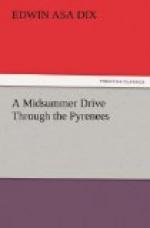Up on a bluff at the right is an old building: it is the abbey of Saint Savin, some of whose stones also could tell us of Charlemagne and perhaps of young Crassus. Farther on, we see, on an opposite slope across the valley, other ruins: a castle; an old tower; and higher still an ancient chapel of the Virgin, cared for to this day, it is said, as in the time of earlier travelers, by the trio of aged women voluntarily pledged to its guardianship and to solitude. Their number remains always the same; upon the death of one, the remaining two make choice of a third to fill her place. It has been thus from unknown periods. Thither repair the women of the valley, on days consecrated to the Virgin, to pay their devotions at this lonely shrine.
Thus together, peace and war, holiness and crime, have dominated this fair region; and with these shivered fortalices and ancient cloisters actually before us, their past seems nearer to possibility. Their relics, attesting the days of feudalism, seem to mourn its departure; the old order has indeed changed and yielded place to new. “It was sweet here to be a monk!” writes Taine, in his warm sympathy with the spirit of this valley; “it is in such places that the Imitation should be read; in such places was it written. For a sensitive and noble nature, a convent was then the sole refuge; all around wounded and repelled it.
“Around, what a horrible world! Brigand lords who plunder travelers and butcher each other; artisans and soldiers who stuff themselves with meat and yoke themselves together like brutes; peasants whose huts they burn,... who out of despair and hunger slip away to tumult. No remembrance of good, nor hope of better. How sweet it is to renounce action, company, speech, to hide one’s self, forget outside things, and to listen in security and solitude to the divine voices that, like collected springs, murmur peacefully in the depths of the heart!”
Farther on still, on another eyrie, is a ruined monastery, St. Orens. This saint came to the Pyrenees from Spain at an early age, and founded this retreat, loving solitude and meditation and austere living. His piety made him widely revered. He long refused the offered archbishopric of Auch; till, doubting his duty in this, he prayed to God for a sign. He was directed to plant a sapling in the earth, and it instantly bloomed into leaves and blossoms; whereupon the hermit wisely inferred that life was designed to bear fruit, not to wither itself away.




